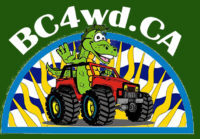In the world of Professional Rigging the equipment used by Crane Operators has to conform to very strict regulations as to the load an item is rated for. In the world of recreational wheeling there are no such regulations, so manufacturers will "fudge" on their ratings with the wording they use.
Equipment intended for professional use in Canada will normally be marked with "WLL" - the Working Load Limit. This is the load that an item such as a strap or shackle can be used to lift day after day until it is retired due to wear. There is a required minimum Design Factor of 3 to 1 for lifting equipment, so if a professional grade shackle is marked with an 4.75 Ton WLL (9,500 lb) then it's minimum breaking strength is upwards of 28,000 lbs. Cheaper equipment not intended for professional use may only have a 2 to 1 Design Factor, so if you don't know for sure then assume it's 2-1. Older or imported equipment may be marked with SWL (Safe Working Load) which means the same.
Most 4x4 equipment such as tow and recovery straps, on the other hand, are rated by Breaking Strength, but do they say WHICH breaking strength?
- Minimum Breaking Load or Minimum Breaking Strength of a strap means that in testing no strap broke below that weight. This is what you want to know. Now figure in a safety factor of 3 to 1 to get your safe WLL. For example a 5,000 lb Jeep TJ should be using straps rated at least 15,000lbs Minimum Breaking Strength.
- Minimum Tensile Strength is similar to Minimum Breaking Load but is an official rating for Synthetic Rope. It is the point at which the individual strands within the rope start to seperate. Again, plan a 3-1 safety factor.
- Average Breaking Strength means that some straps broke at a lower weight and some broke at a higher weight. For a cheaply made strap with poor quality control that could mean that occasionally a strap will fail at half it's rated strength and occasionally a strap will hold to double it's rated strength, so the average is maintained.
- Maximum Breaking Strength means that some straps made it to this load before breaking. This is the worst type of rating and is absolutely useless because you don't know at what load the product is likely to fail.
- Occasionally you will see Load Capacity and Breaking Strength on a product, however this can be misleading as you may assume a safety margin that isn't really there. Usually the numbers given are actually the Minimum and Maximum Breaking Strength.
Another trick used by retailers of Synthetic Winch Rope products is that they will list the rated strength of the rope, not the strength of the finished product after it is wrapped around a thimble and spliced. Any bending will weaken a rope slightly, so read closely when a retailer claims a couple thousand pound higher rating than other companies with a similar diameter product.
You should plan to stay within the Working Load Limit of a piece of equipment, but if you exceed it and are still well within the Design Factor then inspect it for stretching or damage and if it appears fine you could keep using it, however replacing it is safer as damage is not always visible.
If, on the other hand, you exceed the Breaking Strength of a piece of equipment then it must be discarded whether it looks damaged or not.
It is also worth noting that the rating on equipment is for straight pulls under constant load, not angled pulls or "Shock Loading" (like taking a run-up and bouncing at the end of a strap or rope).
If there is no rating on a piece of equipment, especially a shackle or hook DO NOT USE IT. A shackle with a 4,000 lb breaking strength and one with a 24,000 breaking strength could look very similar.

